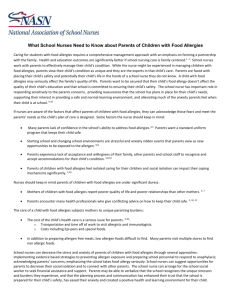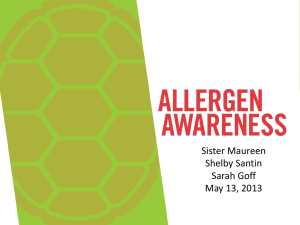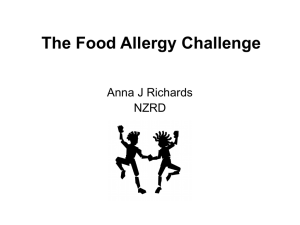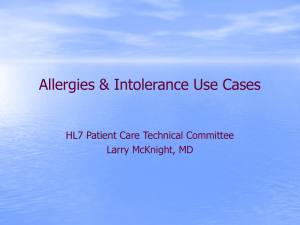overview of food allergies and anaphylaxis
advertisement
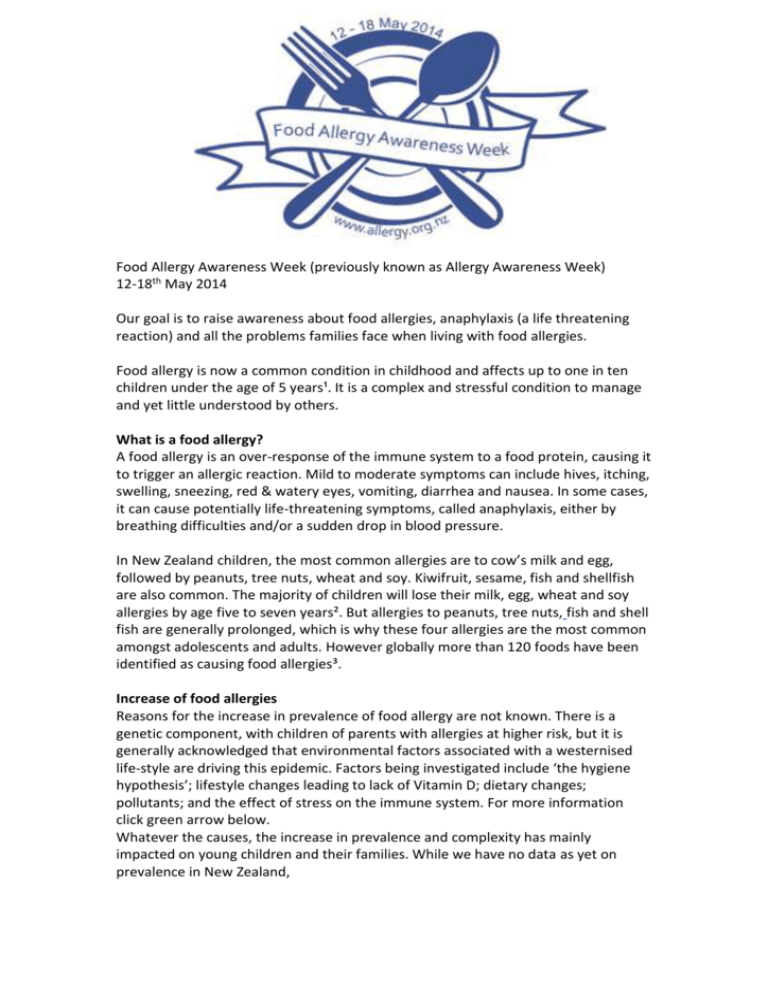
Food Allergy Awareness Week (previously known as Allergy Awareness Week) 12-18th May 2014 Our goal is to raise awareness about food allergies, anaphylaxis (a life threatening reaction) and all the problems families face when living with food allergies. Food allergy is now a common condition in childhood and affects up to one in ten children under the age of 5 years¹. It is a complex and stressful condition to manage and yet little understood by others. What is a food allergy? A food allergy is an over-response of the immune system to a food protein, causing it to trigger an allergic reaction. Mild to moderate symptoms can include hives, itching, swelling, sneezing, red & watery eyes, vomiting, diarrhea and nausea. In some cases, it can cause potentially life-threatening symptoms, called anaphylaxis, either by breathing difficulties and/or a sudden drop in blood pressure. In New Zealand children, the most common allergies are to cow’s milk and egg, followed by peanuts, tree nuts, wheat and soy. Kiwifruit, sesame, fish and shellfish are also common. The majority of children will lose their milk, egg, wheat and soy allergies by age five to seven years². But allergies to peanuts, tree nuts, fish and shell fish are generally prolonged, which is why these four allergies are the most common amongst adolescents and adults. However globally more than 120 foods have been identified as causing food allergies³. Increase of food allergies Reasons for the increase in prevalence of food allergy are not known. There is a genetic component, with children of parents with allergies at higher risk, but it is generally acknowledged that environmental factors associated with a westernised life-style are driving this epidemic. Factors being investigated include ‘the hygiene hypothesis’; lifestyle changes leading to lack of Vitamin D; dietary changes; pollutants; and the effect of stress on the immune system. For more information click green arrow below. Whatever the causes, the increase in prevalence and complexity has mainly impacted on young children and their families. While we have no data as yet on prevalence in New Zealand, global studies show food allergy as the leading cause of anaphylaxis in children³; a seven-fold increase in hospitalizations for anaphylaxis in children in the last 10 years³. A pilot study in which Allergy New Zealand was involved, found high rates of adverse reactions to food in young New Zealand children across all ethnic groups4 most children with food allergy have eczema², and will go on to develop other allergies including environmental allergies causing asthma and/or allergic rhinitis (hayfever)³. Anaphylaxis The incidence of anaphylaxis, which is a severe and life-threatening allergic reaction, is known to be increasing particularly in children, and is associated with the increase in prevalence of food allergy. EAACI (the European Academy of Allergy and Clinical Immunology) state that “the problem is more common than epidemiological studies appear to show, among other reasons because it has an acute and unexpected onset, can vary in severity and also can be spontaneously cured”5. They also state that food allergy is the most common trigger of anaphylaxis in the community, followed by medicines and insect stings. Diagnosis and Management A paper written by New Zealand paediatricians and published in the New Zealand Medical Journal in 2013², provides guidance on the diagnosis and management of IgE-mediated food allergy in children. Specialist referral is recommended in any child with: Definite or possible anaphylaxis Allergy to cows’ milk or multiple food allergies, where expert advice is needed Where there is uncertainty about the diagnosis or interpretation of results Food sensitisation on ssIgE/SPT, where supervised challenge may be necessary to clarify whether there is clinical allergy Allergy to foods such as peanut and nut where the risk of severe allergic reactions is higher Children with asthma and FA, with asthma a risk factor for severe food allergic reaction on accidental exposure Children whose FA persists beyond 5 years of age. However Allergy New Zealand’s CEO, Mark Dixon, notes “education, training and support for health professionals including primary care practitioners, is very limited, and there are few allergy specialists in New Zealand. The result is often significant delays in referral and diagnosis, making it hard for individuals and families to manage effectively on a day to day basis.” Delays in diagnosis and risk management, and/or follow-up of food allergic children can exacerbate health conditions such as eczema and asthma, as well as increase stress and anxiety, limit social interaction and so on. A case study published in 2013 illustrated how such delays can also put children at risk of severe reactions and even death6. Treatment Although there is no cure yet for food allergy, research in the last decade has increased exponentially and researchers are getting closer to developing treatments based on changing the way the immune system responds to allergens through desensitisation - this works much the same way as ‘allergy shots’ work for hay fever. But until these come into fruition, avoiding the allergenic food is the only treatment. Patients and caregivers also have to learn how to treat allergic reactions and particularly be aware of what to do in the case of anaphylaxis. However in saying this, in Allergy New Zealand’s experience, most families are plunged into food allergy with no prior experience of what it is or is involved, and many find the challenges daunting. Food allergy has been described as a hidden disability, and studies indicate a reduced quality of life including long-term effects on health as well as psychological and social well-being. The direct and indirect costs are also significant including medical costs and special foods, as well as lost income and reduced education attainment due to the amount of lost time from work and school7. PHARMAC A critical issue for many at risk of anaphylaxis, as well as their families and communities, is the lack of funding for adrenaline auto-injectors. Anyone diagnosed at risk of anaphylaxis from food or insect venom (bee and wasp) is prescribed an auto-injector and recommended to have with them at all times. However in spite of repeated approaches to Pharmac over the past decade, the Government’s pharmaceutical funding body continues to decline funding. The reason given is essentially that it is not cost effective. “In many ways the measures families and their communities take to minimize the risk of anaphylaxis for children works against them where Pharmac’s funding model is concerned” says Mark. “It doesn’t take into account the costs they are incurring and the stress associated with the uncertainty of anaphylaxis and the need to always be on your guard. Autoinjectors are a bit like seat belts, you never know when you are going to need them, so the recommendation is to have them with you always.” Petition Allergy New Zealand has vowed to continue the campaign for funding and fully supports the petition created by Wellington mum, Helen Richardson. The petition has attracted more than 9000 signatures (online and hard copy) and Helen is planning to take her campaign to the House of Representatives. “Is is estimated 1 in 10 children born in New Zealand will develop food allergies and many of these children will have multiple food allergies. A significant number of these children will experience an anaphylactic episode triggered by a food allergen and will be prescribed an adrenaline auto-injector. This is a critical life saving treatment but many kiwis cannot afford to fill or renew prescriptions for this treatment and my campaign is about ensuring this inequity is address as a matter of public health policy,” says Helen. Be aware, Show You Care* About Allergy New Zealand Allergy New Zealand is a national charity dedicated to providing reliable information, education and support so you can manage your or your child's allergy and live an active and healthy lifestyle. We also represent their interests particularly to government, policy makers and the media, provide information and guidance to the health, education and food sectors, and support research. www.allergy.org.nz Contact Allergy New Zealand Karina Yanez, Communications Manager comms@allergy.org.nz 021 0842 2680 1. Osborne et al. Prevalence of challenge-proven IgE-mediated food allergy using population-based sampling and pre-determined challenge-criteria in infants. Journal of Allergy & Clin Immunol, 2011. 2. Sinclair et al. IgE_mediated food allergy – diagnosis and management in New Zealand children. NZMJ 2013 3.EAACI: Food Allergy & Anaphylaxis Public Declaration. FAAM 2013 (www.eaaci.org) 4. Crooks et al. Adverse reactions to food in New Zealand children age 0-5 years. NZMJ 2010 5.EAACI. Up to 22% of European children have an allergy, with serious reaction to food on the rise. April 2014 (www.eaaci.org) 6.JanSinclair. Fatal food allergy and opportunities for risk minimization. NZMJ, May 2013. 7. Gupta et al. The economic impact of childhood food allergy in the United States. 8. *Used with permission from Allergy & Anaphylaxis Australia 2014



